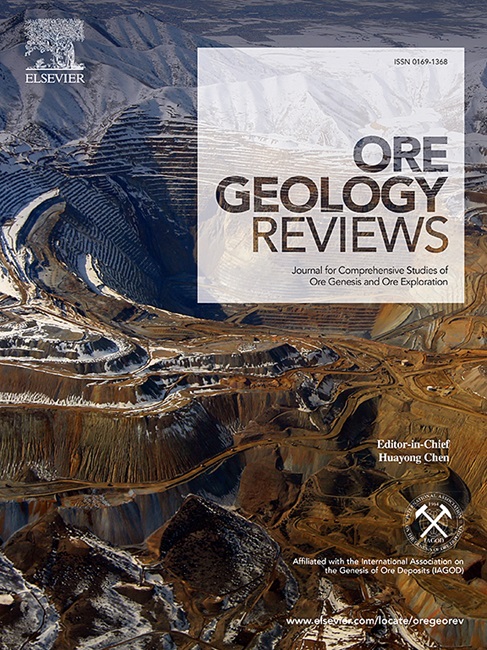Geology, geochemistry, and zircon U-Pb geochronology of the Nanthila and Pedet granites in the Myeik Sn-W district, Tanintharyi region, southern Myanmar
IF 3.6
2区 地球科学
Q1 GEOLOGY
引用次数: 0
Abstract
Critical metals, particularly tin and tungsten, are essential to global economic development and modern civilization. The Southeast Asian Tin Belt, extending 2800 km, represents the world’s most significant W–Sn metallogenic belt. This belt includes four metallogenic provinces: the Main Range Granitoid Province, the Northern Granitoid Province (North Thailand Migmatitic Province), the Eastern Granitoid Province, and the Western Granitoid Province), with ore assemblages predominantly associated with Phanerozoic intrusions. The Western Granitoid Province of southern Myanmar hosts numerous W-Sn mineralized granitoids, among which we investigated the Nanthila and Pedet granitic plutons in the Myeik Sn-W district. The study area consists primarily of the Carboniferous-Permian Mergui Group and Early Tertiary granitic rocks. The petrogenesis, tectonic setting, magmatic evolution, and the age of the Nanthila and Pedet granitic intrusions remain poorly constrained. This contribution reports field observations, petrographic studies, whole-rock geochemical analyses, in-situ U-Pb zircon dating, Lu-Hf isotopic data, and mineral chemistry analysis. Petrographic and geochemical data reveal that both plutons exhibit high SiO2 (74.63–76.43 wt%), low CaO (0.62–0.73 wt%) and MgO (0.02–0.13 wt%) contents, elevated 10000*Ga/Al ratios (2.94–3.67), mildly peraluminous nature (A/CNK < 1.1), and high-K calc-alkaline affinity. They show high HFSEs concentrations (Y: 8.1–14.8 ppm, Nb: 25.3–40.4 ppm, Th: 41.9–103 ppm, and U: 19.8–29.7 ppm) and moderate to high melting temperatures (zircon: 731–806 °C; apatite: 709–813 °C). These characteristics align with highly fractionated aluminous A2-type granites, displaying “V” type REE distribution patterns with pronounced negative Eu anomalies. The Sn-related granitic magmas likely originated from the partial melting of clay-rich felsic crustal sources under reduced conditions and high temperatures in a post-collisional tectonic setting. Magmatic zircons from six granitoid samples yielded Concordia ages of ∼ 50.78 ± 0.47 Ma to 51.46 ± 0.43 Ma (Eocene period). The 176Hf/177Hf ratios (0.282271 to 0.282541), negative εHf(t) values (−7.18 to −16.74), and two-stage crustal model ages (TDMC) (1.58–2.01) indicate derivation from Neoproterozoic continental crust. These findings highlight the potential of the Nanthila and Pedet areas for further geological investigation and mineral exploration, suggesting they could be promising sites for new reserves.

缅甸南部Tanintharyi地区Myeik Sn-W地区Nanthila和petet花岗岩地质、地球化学及锆石U-Pb年代学
锡、钨等重要金属是世界经济发展和现代文明的重要组成部分。东南亚锡带全长2800公里,是世界上最重要的锡钨成矿带。该带包括4个成矿区:主岭花岗岩区、北花岗岩区(泰国北混染岩区)、东花岗岩区和西花岗岩区,矿石组合以显生宙侵入岩为主。缅甸南部西部花岗岩类省发育大量钨锡矿化花岗岩类,其中在Myeik Sn-W地区研究了Nanthila和petet花岗岩类岩体。研究区主要发育石炭—二叠系默桂群和早第三纪花岗岩。Nanthila和petet花岗质侵入岩的岩石成因、构造背景、岩浆演化和时代仍然缺乏明确的认识。该贡献报告了野外观测、岩石学研究、全岩地球化学分析、原位U-Pb锆石定年、Lu-Hf同位素数据和矿物化学分析。岩石学和地球化学数据显示,这两个岩体均表现出高SiO2 (74.63 ~ 76.43 wt%)、低CaO (0.62 ~ 0.73 wt%)和低MgO (0.02 ~ 0.13 wt%)含量,高10000*Ga/Al比值(2.94 ~ 3.67),轻度过铝性质(A/CNK <;1.1),高钾钙碱性亲和力。它们具有较高的HFSEs浓度(Y: 8.1 ~ 14.8 ppm, Nb: 25.3 ~ 40.4 ppm, Th: 41.9 ~ 103 ppm, U: 19.8 ~ 29.7 ppm)和中至高的熔融温度(锆石:731 ~ 806℃;磷灰石:709-813°C)。这些特征与高分馏的a2型铝质花岗岩一致,呈“V”型稀土分布模式,Eu负异常明显。与sn相关的花岗质岩浆可能是在碰撞后构造环境下高温还原条件下富粘土长英质地壳源部分熔融形成的。6个花岗岩样的岩浆锆石的Concordia年龄为~ 50.78±0.47 Ma ~ 51.46±0.43 Ma(始新世)。176Hf/177Hf比值(0.282271 ~ 0.282541),εHf(t)值为负(- 7.18 ~ - 16.74),两期地壳模式年龄(TDMC)(1.58 ~ 2.01)表明其来源于新元古代大陆地壳。这些发现突出了Nanthila和petet地区进一步地质调查和矿产勘探的潜力,表明它们可能是新储备的有希望的地点。
本文章由计算机程序翻译,如有差异,请以英文原文为准。
求助全文
约1分钟内获得全文
求助全文
来源期刊

Ore Geology Reviews
地学-地质学
CiteScore
6.50
自引率
27.30%
发文量
546
审稿时长
22.9 weeks
期刊介绍:
Ore Geology Reviews aims to familiarize all earth scientists with recent advances in a number of interconnected disciplines related to the study of, and search for, ore deposits. The reviews range from brief to longer contributions, but the journal preferentially publishes manuscripts that fill the niche between the commonly shorter journal articles and the comprehensive book coverages, and thus has a special appeal to many authors and readers.
 求助内容:
求助内容: 应助结果提醒方式:
应助结果提醒方式:


